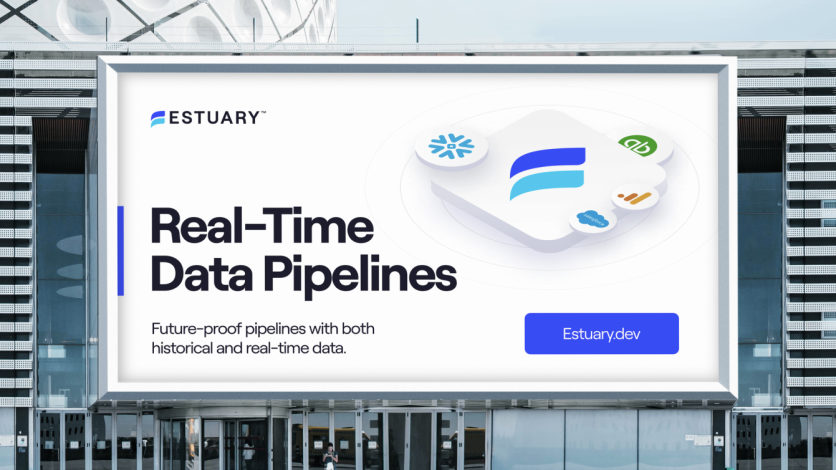Enterprise data infrastructure is at a breaking point. Organizations are drowning in complexity as they struggle to manage the increasing demands of real-time analytics, personalized customer experiences, and AI-driven features. Traditional ETL and ELT approaches were not designed for today's demands. They force teams to patch together separate tools, creating fragile integrations that break when you need them most.
The result is a brittle chain of systems where a single failure can bring down multiple systems, data arrives hours or days late, and costs spiral as teams add more tools to solve each problem. Engineering teams get trapped in maintenance mode instead of shipping the features that actually drive business value.

Addressing this problem is Elif Sen, who has spent her career at the intersection of technology and business strategy. Since joining Estuary during its early days, Sen has been shaping the company's strategy while staying at the forefront of this infrastructure evolution. Estuary solves the fragmentation problem by unifying streaming and batch data pipelines in one platform, and she works directly with customers navigating this transition, translating their operational pain points into solutions that can scale with their business.

Breaking Down the Fragmented Data Stack
For developers building modern data infrastructure, fragmentation has become a constant headache. Analytics, operations, and AI/ML use cases each require their own pipeline, creating a sprawl of tools held together with brittle integrations. As Sen puts it, this turns engineering teams into 'infrastructure babysitters,' constantly hunting down failures instead of building the product.
"Fragmentation makes implementation complex," she explains. "Teams want to build one thing but end up managing five different tools just to move data around."
The operational costs pile up fast. Fragmentation means more things that can go wrong, longer waits for simple changes, and infrastructure bills that keep getting bigger. Real-time features (once touted as transformative for everything from customer personalization to operational dashboards) often remain out of reach because the systems needed to support them require too much engineering effort to implement reliably.
In practice, launches get delayed, costs spiral out of control, and developers spend their days fixing data pipelines instead of building features customers want. As the data stack grows, the complexity becomes increasingly paralyzing, and most teams ultimately accept these limitations rather than tackling the ever-growing technical debt.

How Estuary Solves This
Estuary tackles this problem by consolidating streaming and batch workflows. Instead of forcing companies to maintain separate systems or completely rebuild their infrastructure when they outgrow batch processing or need new capabilities, Estuary lets teams start simple and scale up, running both real-time streams and scheduled batch jobs on the same platform.
"One of Estuary's key strengths is that we can handle both real-time and batch processing with the same simplicity," Sen explains. "You don't need different tools for different workloads."
This flexibility matters because business requirements rarely stay static. A team might start with nightly ETL jobs for reporting, then discover they need live customer analytics, real-time operational monitoring, or streaming data for machine learning models. Traditionally, this evolution meant a painful infrastructure overhaul and rebuilding systems from scratch with new tools and architectures. Estuary eliminates that bottleneck.
"The smart approach," Sen says, "is giving teams one platform that scales with their business needs, so they're not locked into architectural decisions they made on day one. This gives businesses the flexibility to evolve their data infrastructure without rebuilding their entire stack as they grow and add new use cases."
For many businesses, this has opened up possibilities they hadn't originally considered. What starts as simple reporting often evolves into real-time customer data platforms, instant customer behavior tracking, and live operational metrics, all while enabling teams, even with limited technical expertise, to build enterprise-grade pipelines in minutes.
Translating Customer Needs Into Strategy
Elif sits at the intersection of customer feedback, product development, and business strategy. Her role involves turning loosely defined customer feedback into clear product direction, while making sure the team builds solutions that solve the right problems.
"Customers tell you what they think they need," she explains, "but it's our job to uncover the real problem they're trying to solve." This approach has shaped Estuary's product roadmap, ensuring features address consistent and systemic pain points rather than one-off requests. By identifying patterns across customer feedback, she uncovers opportunities to refine Estuary's broader strategy.
For example, Sen worked to fine-tune Estuary's pricing structure based on customer usage patterns, making costs more predictable and better aligned with how businesses scale with the platform. Similarly, on the product side, she helps prioritize feature requests like new data source connectors based on broader market demand and strategic fit, rather than just addressing individual requests as they come in.
Her goal is to ensure Estuary integrates seamlessly with how teams already operate, rather than requiring them to adopt new rigid systems.
The Future of Data Infrastructure
Choosing data infrastructure feels risky for many teams, as picking the wrong platform today could mean expensive rebuilds tomorrow. Sen believes this is exactly why platforms like Estuary will define the next generation by being flexible enough to adapt to each business's evolving needs.
Her vision for the future includes platforms that can handle whatever new use cases emerge, whether that's processing real-time customer behavior for personalization, supporting new regulatory compliance needs, or integrating with technologies that don't exist yet. The key is building systems that scale with the direction the business takes.
For now, Sen's focus remains on delivering unified, reliable tools that free teams to build what matters instead of wrestling with infrastructure complexity.
ⓒ 2025 TECHTIMES.com All rights reserved. Do not reproduce without permission.




